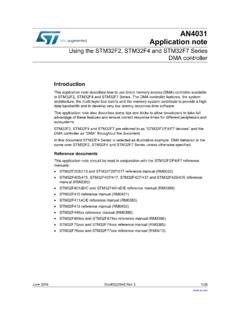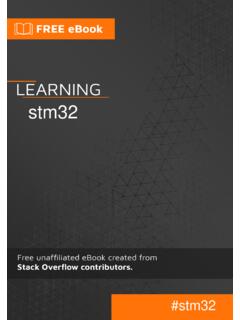Transcription of -M0+/M3/M4 and M7 design which supports the MPU.
1 IntroductionThis application note describes how to manage the memory protection unit (MPU) in the STM32 products. The MPU is anoptional component for the memory protection. Including the MPU in the STM32 microcontrollers (MCUs) makes them morerobust and reliable. The MPU must be programmed and enabled before using it. If the MPU is not enabled, there is no changein the memory system application note concerns all the STM32 products listed in Table 1 that include Cortex -M0+/M3/M4 and M7 design whichsupports the more details about the MPU, refer to the following documents available on Programming manual stm32f7 series and STM32H7 series Cortex -M7 processor (PM0253) Programming manual STM32F10xxx/20xxx/21xxx/L1xxxx Cortex -M3 (PM0056) Programming manual Cortex -M0+ for STM32L0, STM32G0, STM32WL and STM32WB series (PM0223) Programming manual STM32 Cortex -M4 MCUs and MPUs (PM0214) Programming manual STM32 Cortex -M33 MCUs (PM0264)Table 1.
2 Applicable productsTypeProduct seriesMicrocontrollers STM32F1 series , stm32f2 series , STM32F3 series , stm32f4 series , stm32f7 series STM32G0 series , STM32G4 series STM32H7 series STM32L0 series , STM32L1 series , STM32L4 series , STM32L4+ series , STM32L5 series STM32U5 series STM32WB SeriesManaging memory protection unit in STM32 MCUsAN4838 Application noteAN4838 - Rev 5 - September 2021 For further information contact your local STMicroelectronics sales informationThis application note applies to STM32 microcontrollers Arm -based :Arm is a registered trademark of Arm Limited (or its subsidiaries) in the US and/or informationAN4838 - Rev 5page 2/202 OverviewThe MPU can be used to make an embedded system more robust and more secure by: prohibiting the user applications from corrupting data used by critical tasks (such as the operating systemkernel) defining the SRAM memory region as a non-executable (execute never XN) to prevent code injection attacks changing the memory access attributesThe MPU can be used to protect up to sixteen memory regions.
3 In Armv6 and Armv7 architecture (Cortex-M0+,M3, M4, and M7, this regions in turn can have eight subregions, if the region is at least 256 bytes. The exactamount of regions protected can vary between core and devices in the STM32, refer to Table 1 for more subregions are always of equal size, and can be enabled or disabled by a subregion number. Because theminimum region size is driven by the cache line length (32 bytes), eight subregions of 32 bytes corresponds to a256-byte regions are numbered 0 to 15. In addition, there is a region called the default region with an id of -1. All the0-15 memory regions take priority over the default regions can overlap, and can be nested. The region 15 has the highest priority and the region 0 hasthe lowest one and this governs how overlapping the regions behave.)
4 The priorities are fixed, and cannot Armv8 architecture (Cortex-M33) the regions are defined using a base and a limit address offering flexibility andsimplicity to the developer on the way to organise them. Additionaly the Cortex-M33 does not include subregionsas the region size is now more figure below shows an example with six regions. This example shows the region 4 overlapping the regions0 and 1. The region 5 is enclosed completely within the region 3. Since the priority is in an ascending order, theoverlap regions (in orange) have the priority. So if the region 0 is writeable and the region 4 is not, an addressfalling in the overlap between 0 and 4 is not 1. Example of overlapping regionsRegion 4 Region 0 Region 1 Region 2 Region 5 Region 304 GbytesRegionsOverlap regionsCaution:In Armv8 architecture (Cortex-M33), regions are now not allowed to overlap.
5 As the MPU region definition ismuch more flexible, overlapping MPU regions is not - Rev 5page 3/20 The MPU is unified, meaning that there are not separate regions for the data and the MPU can be used also to define other memory attributes such as the cacheability, which can be exported tothe system level cache unit or to the memory controllers. The memory attribute settings in Arm architecture cansupport two levels of cache: inner cache and outer cache. For the stm32f7 and STM32H7 series , only one levelof cache (L1-cache) is cache control is done globally by the cache control register, but the MPU can specify the cache policy andwhether the region is cacheable or modelIn STM32 products, the processor has a fixed default memory map that provides up to 4 Gbytes of 2.
6 Cortex -M0+/M3/M4 /M7 processor memory map0x0000 00000x1 FFF FFFF0x3 FFF FFFF0x5 FFF FFFF0x9 FFF FFFF0xDFFF FFFF0xE00F FFFF0xFFFF FFFFV endor-specific memoryExternal RAMP eripheralSRAMCodeExternal devicePrivate peripheral Mbyte511 Mbytes0x2000 00000x4000 00000x6000 00000xA000 00000xE000 00000xE010 0000AN4838 Memory modelAN4838 - Rev 5page 4/20 Figure 3. Cortex-M33 processor memory mapCortex M33 Non-secureOCTOSPI1 bankNon-secureFMC bank 3 Non-secureFMC bank 1 Non-securePeripheralsNon-secure callablePeripheralsNon-secureSRAM2 Non-secure callableSRAM 2 Non-secureCodeNon-secureCodeNon-secure callableCodeNon-secureReservedAHB3 ReservedAHB2 ReservedAHB1 ReservedAPB2 ReservedAPB1 ReservedAHB3 ReservedAHB2 ReservedAHB1 ReservedAPB2 ReservedAPB1 ReservedRSSR eservedSRAM2 SRAM1 ReservedFLASHR eservedOTPR eservedSystem memoryReservedSRAM2 SRAM1 ReservedFLASHE xternal memories remap0xFFFF FFFF0xE000 00000xA000 00000x9000 00000x8000 00000x7000 00000x6000 00000x5000 00000x4000 00000x3003 00000x2003 00000x1000 00000x0C00 00000x0000 00000x6000 00000x5402 20000x5402 00000x520C 80000x5202 00000x5003 30000x5002 00000x5001 68000x5001
7 00000x5000 E0000x5000 00000x5000 00000x4402 20000x4402 00000x420C 84000x4202 00000x4003 34000x4002 00000x4001 68000x4001 00000x4000 E0000x4000 00000x0C00 00000x0 BFB 00000x0 BFA 00000x0BF9 7 FFF0x0BF9 00000x0A04 00000x0A03 00000x0A00 00000x0808 00000x0800 00000x0000 00000x1000 00000x0FF8 27FF0x0FF8 00000x0E04 00000x0E03 00000x0E00 00000x0C08 00000x0C00 0000 Non-secure Non-secure callableSRAM 1 Non-secure0x2000 0000 SRAM1 Non-secure callable0x3000 0000AN4838 Memory modelAN4838 - Rev 5page 5/203 Cortex -M0+/M3/M4 /M7 memory types, registers and attributesThe memory map and the programming of the MPU split the memory map into regions. Each region has a definedmemory type, and memory attributes. The memory type and attributes determine the behavior of accesses to typesThere are three common memory types: Normal memory: allows the load and store of bytes, half-words and words to be arranged by the CPU inan efficient manner (the compiler is not aware of memory region types).
8 For the normal memory region theload/store is not necessarily performed by the CPU in the order listed in the program. Device memory: within the device region, the loads and stores are done strictly in order. This is to ensure theregisters are set in the proper order. Strongly ordered memory: everything is always done in the programmatically listed order, where the CPUwaits the end of load/store instruction execution (effective bus access) before executing the next instructionin the program stream. This can cause a performance attributesThe region attributes and size register (MPU_RASR) are where all the memory attributes are set. The tableshows a brief description of the region attributes and size in the MPU_RASR 2. Region attributes and size in MPU_RASR registerBitsNameDescription28 XNExecute never26:24 APData access permission field (RO, RW or No access)21:19 TEXType extension field18 SShareable17 CCacheable16 BBufferable15:8 SRDS ubregion disabled.
9 For each subregion 1 = disabled, 0 = :1 SIZES pecifies the size of the MPU protection of the previous table are detailed below: The XN flag controls the code execution. In order to execute an instruction within the region, there must beread access for the privileged level, and XN must be 0. Otherwise a MemManage fault is +/M3/M4/M7 memory types, registers and attributesAN4838 - Rev 5page 6/20 The data access permission (AP) field defines the AP of memory region. The table below illustrates theaccess permissions:Table 3. Access permissions of regionsAP[2:0]Privileged permissionsUnprivileged permissionsDescription000No accessNo accessAll accesses generate a permission fault001 RWNo accessAccess from a privileged software only010 RWROW ritten by an unprivileged software generates a permissionfault011 RWRWFull access100 UnpredictableUnpredictableReserved101 RONo accessRead by a privileged software only110 RORORead only, by privileged or unprivileged software111 RORORead only, by privileged or unprivileged software The S field is for a shareable memory region: the memory system provides data synchronization betweenbus masters in a system with multiple bus masters, for example, a processor with a DMA controller.
10 Astrongly-ordered memory is always shareable. If multiple bus masters can access a non-shareable memoryregion, the software must ensure the data coherency between the bus masters. The stm32f7 series andSTM32H7 series do not support hardware coherency. The S field is equivalent to non-cacheable memory. The TEX, C and B bits are used to define cache properties for the region, and to some extent, itsshareability. They are encoded as per the following 4. Cache properties and shareabilityTEXCBM emory TypeDescriptionShareable00000 Strongly OrderedStrongly OrderedYes00001 DeviceShared DeviceYes00010 NormalWrite through, no write allocateS bit00011 NormalWrite-back, no write allocateS bit00100 NormalNon-cacheableS bit00101 ReservedReservedReserved00110 UndefinedUndefinedUndefined00111 NormalWrite-back, write and read allocateS bit01000 DeviceNon-shareable deviceNo01001 ReservedReservedReserved The subregion disable bits (SRD) flag whether a particular subregion is enabled or disabled.











